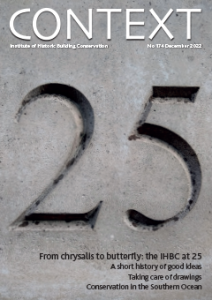 Marking the 25th anniversary of the IHBC – #IHBC 25 – our ‘IHBC at 25’ issue of Context looks back at where today’s multidisciplinary institute came from, how it has evolved and where it might go, and this celebratory NewsBlog features Mary King, Chair during the founding, on its origins.
Marking the 25th anniversary of the IHBC – #IHBC 25 – our ‘IHBC at 25’ issue of Context looks back at where today’s multidisciplinary institute came from, how it has evolved and where it might go, and this celebratory NewsBlog features Mary King, Chair during the founding, on its origins.
… No gongs, no black ties, but plenty of tea, sympathy and pints down the pub with our friends…
Mary King writes in Context:
As the Association of Conservation Officers was not a professional institute, who could define the role of the conservation officer? From such questions the IHBC was born.
… I can not believe that it is a quarter of a century since we stood in a derelict St Pancras Chambers for the institute’s launch. Both St Pancras and the institute have changed a lot since, but I have to say that the IHBC looked in better shape than St Pancras on the day.
The IHBC did not appear overnight but grew out of the Association of Conservation Officers (ACO). We did not want to be too formal or regulated. Chris Smith, our then chairman, promised that ‘Whatever the ACO becomes in the future… there should never be a gong for the chairman, or expensive black-tie dinners… which would get in the way of us meeting as friends’1.
But times they were a-changing, and it was clear that we needed to change too. With the introduction of NVQs (National Vocational Qualifications), work was under way to define the competencies of the different professions. A meeting of COTAC (Council for Training in Architectural Conservation) attended by our education officer, Micky King, discussed whether the RIBA, the RICS or the RTPI might be best placed to define the role of the conservation officer. When Micky suggested that the ACO could do it, it was pointed out quite sharply that the ACO was not an institute and that being a conservation officer was not a profession.
During a period of considerable turmoil for conservation, it also became clear that our responses to a spate of significant consultations from English Heritage and the government did not have the same weight as those of the professional institutes. We had never set out to be a campaigning organisation, but we could see that if we did not want conservation, and our role in it, to be defined by others, we would have to take our future into our own hands.
Twenty-five years on, it is a pleasure to see how our chick has grown into a fully-fledged institute, with its own membership standards, close links with the rest of the conservation community and a strong voice in debates about the heritage. Best of all, the IHBC has carried forward the beliefs that were at the core of the ACO; that conservation is not just about the past, but about taking our heritage into the future and developing, using and loving it as part of our day-to-day lives. If historic buildings and places are to survive, they must earn their own living and be enjoyed where we live and work, not just treated as museums to be visited on our days off. Heritage-led regeneration adds value to places, tying together their past and their future, and providing a sense of the history that lies behind them. It is good to see that this is still at the heart of the IHBC’s approach.
Perhaps equally important, the IHBC has remained essentially a group of friends, sharing experience and information with each other and welcoming those new to the profession. No gongs, no black ties, but plenty of tea, sympathy and pints down the pub with our friends.
The articles in this IHBC 25th anniversary issue of Context look not only at where we have come from, but more important, where we are going. We did not just take our future into our hands on that fateful day in 1997, we took the future of the past into our care as well. Long may the IHBC continue to support both.
See Mary King in Context HERE
See the full issue HERE
See more on Context HERE
Reading Context helps IHBC members develop their skills across all of the IHBC’s Areas of Competence, and so is a critical baseline in addressing priorities in Continuing Professional Development (CPD)
Access the online archive
See more IHBC background and guidance on IHBC CPD and on how you might use past, current and future issues of Context
See the formal guidance paper on IHBC CPD (scheduled for update)
See more on the IHBC Competences and Areas of Competence
See more on #IHBC25

